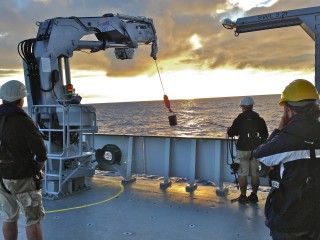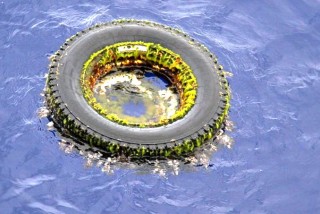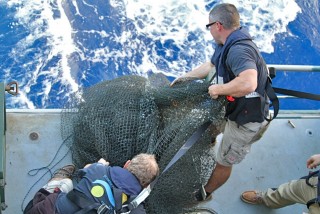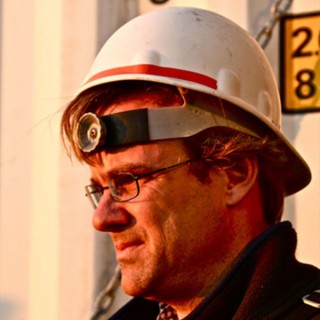
In recent years there has been growing attention paid to the accumulation of plastic waste in the ocean, but the focus has been on relatively large chunks of plastic.
But very little research has yet focused on the concentrations of miniscule, eroded bits of plastic that are invisible to human eyes yet could pose significant ecological threats. Falkor’s transit from Seattle, Washington to Honolulu has proven an ideal opportunity for one researcher to begin studying this topic in detail.
Jenni Brandon, a Ph.D. student working on a degree in biological oceanography at Scripps Institution of Oceanography is collecting water samples during the 10-day transect to analyze for concentrations of plastic nanoparticles.
Several high-profile expeditions over the past few years have studied the amount of plastic material accumulating in gyres—places where ocean currents tend to circulate, which can cause surface materials to concentrate in spinning patterns miles across. “Think of the gyre sort of like a sink draining, only there is no drain in the middle.” says Brandon, “All the trash gets carried to the middle where there aren’t very strong wind or currents so it just gets stuck.”

While some feared that certain gyres were effectively creating floating islands of plastic waste, researchers have instead found that the plastics tend to be plentiful, but are usually more spread out. Ecologically this could pose less of a threat, even if the pattern remains an exceedingly unpleasant outcome of human pollution. Indeed, the crew has been disturbed by some of what they’ve seen from Falkor on the way through one of the key plastics zones, the North Pacific Subtropical Gyre, a little less than halfway between Washington State and Hawaii.
More to the Story
But the spread out larger plastic pieces may only tell part of the story. “What we as ecologists realized is that this is probably a bigger problem,” says Brandon. If plastics are broken up and spread out, that means it could be a lot easier for the material to enter the food web, consumed as small bits by base organisms like filter feeding zooplankton that end up eating whatever is in the water that’s within a certain size range.”
In 2009, Brandon’s group at Scripps did a Pacific expedition where they towed nets with various mesh sizes and analyzed the amount of plastic pieces in each size range. The smallest mesh net had holes that were the width of about 3 human hairs—333 microns. But it’s bits even smaller than that—nanoparticles—that the animals like tiny copepods at the base of the food web would be most likely to take in. “There was kind of this gap of knowledge,” says Brandon, “No one really knew how to analyze that lower bound.”
So when the Falkor opportunity came about, Brandon, working with her Ph.D. advisor, Mark Ohman at Scripps, set about devising a way to analyze that much smaller fraction. Nets are not an option, so instead she is working with the crew twice a day to simply lower a bucket over the side of the ship to collect a water sample. She uses a metal bucket to make sure no plastic comes from the bucket itself, and they use the crane to keep the bucket from picking up any plastic bits from the ship’s hull. She then pumps this water through filters with mesh sizes of 5 microns and 0.7 microns.
The Challenge

One of the reasons no one has studied plastic nanoparticles is that there’s no simple way to do the analyses. Brandon’s plan is to analyze the filters using Raman spectroscopy, which involves measuring how laser light scatters as it goes through a material. Different types of plastics scatter the light in signature ways, so by moving a filter through the device she should be able to identify the spots where otherwise invisible particles are located. But that won’t happen until she’s back at a lab onshore. “When the crew asks me if I found any plastic yet, I say, ‘I might have but I can’t see it.’”
If this technique works, she’ll ultimately be able to say how many particles were found in a given volume of water filtered and from there begin to work out potential ecological impacts. If for some reason that technique doesn’t work, she’ll explore other options such as using a scanning electron microscope.
Brandon is also storing a few extra samples from each bucket of water. Some she’ll analyze to look at the bacteria present. Some researchers believe that plastics can change bacterial species composition by favoring those that can consume plastic, and the bacteria may be helping break down larger pieces of plastic to help form the nanoparticles. So Brandon hopes to determine if there are any noticeable differences in bacterial communities in places where concentrations of plastic nanoparticles are higher. She and her colleagues expect it will take about 18 months to complete the analyses.

